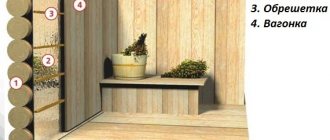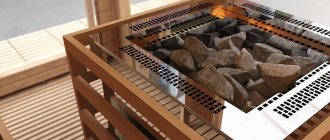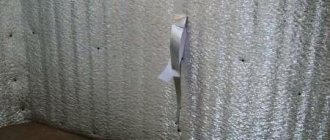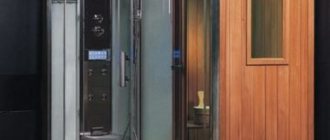The healing effect of saunas of all types is based on thermal effects, the source of which can be various technical devices. A person is enveloped in wet steam or dry heated air in steam rooms of the Russian, Finnish or Turkish type.
Infrared sauna heaters operate in a completely different way, heating bodies and other objects through the penetration of rays inside. In this case, the air temperature can increase due to the release of thermal energy not only from the source of the waves, but also from surrounding objects.
Advantages of IR heaters
When visiting ordinary baths, a person finds himself in a space whose air is heated by direct heat transfer from electrical, gas equipment or from steam obtained using a steam generator.
In recent decades, the popularity of saunas with IR heaters has been increasing, the operating principle of which is based on the laws of not only thermodynamics, but also optics.
It turned out that radiation in the specified range has a beneficial effect on the body, warming it from the inside surrounded by ordinary air. The advantages of infrared heaters for baths over traditional heat sources are as follows:
- the heat source is small in size;
- installation is simple and quick;
- electricity consumption is much less than other devices;
- the original concentration of oxygen is maintained in the air;
- bad odors and fuel oxidation products do not accumulate in the space;
- if desired, you can direct the rays locally, to one zone;
- The temperature in the sauna increases quickly;
- due to the absence of convection, the formation of drafts is excluded;
- the proportion of moisture in the air does not change in the room;
- installation in apartments of high-rise buildings is possible.
Of course, it is worth remembering the possible disadvantages; It’s better to think through all aspects in advance so as not to be disappointed later.
You should understand that such a bathhouse is not suitable for the largest companies and not for every person, so before visiting you need to consult a doctor.
Installing IR heaters in a sauna entails the need to purchase additional equipment, so the total investment will be noticeable on the budget.
The impressions from the visit are undoubtedly pleasant, but they are somewhat different from the memories of traditional steam rooms with stoves, which have their own charm.
Equipment requirements upon purchase
When purchasing an IR heater, you should check the following points:
- integrity of the packaging, presence of protective linings on the case;
- checking the device for operability - the seller has no right to refuse;
- silent operation of the unit - if there are extraneous sounds, then it is better not to buy this device;
- provision of a warranty card and purchase receipt;
- the seller has quality certificates for the goods.
If one or more of the listed conditions are not met, you should refuse to purchase the product in this store.
Principle of operation
The operation of an infrared heater is based on the fact that the emitter delivers waves of a strictly defined length into the surrounding space.
IR radiation is the region between the visible part of the spectrum (wavelength 0.74 μm) and microwave radio radiation (wavelength 2000 μm). Infrared wave vibrations have a wide range of values, which is divided into three types of waves:
- close (short);
- average;
- distant (long).
The first group has a length from the value of the beginning of the region to 2.5 μm; the third group has a length from the end of the region to 50 μm; the second group has a length whose values fall in the middle.
Differences in wavelength affect the properties, appearance of infrared emitters, flow transmission speed, heating intensity of the actual working elements, and the dimensions of the room for which the equipment is intended.
Models with a short-wave beam flux during operation are slightly colored in yellow-red shades, the temperature of the heating element can reach 1000 ° C. Such equipment is recommended to be installed in high production workshops, with a ceiling height of about 9 m.
Heaters emitting rays of medium length are suitable for quickly increasing the temperature in rooms whose height does not exceed 6 m. The device has a heating element with a maximum temperature reached during operation of 600 °C.
Long-wavelength models deliver waves that penetrate deeply into objects, in particular the human body. In this case, the working element itself heats up to 300 °C. Such infrared equipment is suitable for small spaces, saunas, office premises with a ceiling height not exceeding 3 m.
Will the impact be beneficial?
Despite the intense heating and sweating, an infrared sauna cannot be associated with exclusively therapeutic effects. Whether an infrared sauna will be beneficial or not will depend on the following indicators:
- infrared wavelengths;
- session duration;
- individual human ability to tolerate thermal radiation.
Infrared wavelength
Any body or object heated to a certain temperature is a source of infrared radiation. And the human body is no exception - it continuously emits invisible IR rays with a wavelength of 6 - 20 microns. Scientists have proven that infrared waves will be perceived by a person as “our own” if their length corresponds to the radiation of the human body.
The heaters in the infrared sauna are “tuned” to emit rays with a wavelength of 7 - 14 microns. Accordingly, this radiation is in the “native” range for humans and theoretically cannot act harmfully. Of course, if you use it without fanaticism and strictly follow the regime and duration of visiting the IR cabin.
Session duration
Any therapeutic procedure, including an infrared sauna, can harm a person if used in excess. An infrared sauna affects the human body more intensely than other types of baths. Therefore, doctors do not recommend staying there for longer than 20–30 minutes. If you have problems with the heart or brain, the duration of your stay in the infrared sauna should be reduced to 5-10 minutes. It's better to make several short visits than one long visit!
Individual characteristics of a person
There are people who are not able to withstand intense heat radiation for long. This may be due to both diseases and individual characteristics. Therefore, if, after entering the IR cabin, you feel a burning sensation in the skin and nasopharynx, watery eyes, headaches or dizziness, leave immediately. You should not take procedures “forcibly” - such a sauna will not be beneficial, on the contrary, it can be very dangerous.
In addition to individual intolerance, there are also contraindications for an infrared sauna, justified by doctors - painful conditions in which long-term thermal exposure is undesirable.
Kinds
For saunas, IR heaters powered by electricity are used; devices that use the combustion energy of gas or diesel fuel are inconvenient to operate in such conditions.
Infrared heating elements are made from various materials that produce waves of a certain length; The design comes in a variety of forms.
Note! Ceramic products in which the element is made in the form of a panel are popular.
Inside the plane there is an emitter made of nichrome, capable of heating up to 1000 ℃, or fechral, the operating temperature of which is 800 ℃. Infrared heaters with a ceramic surface are successfully used in intensive mode for 4 years, after which repair or replacement of the element may be necessary.
The heater can be hung on the ceiling or walls, while the temperature regulator is located in a place convenient for users.
IR lamps with a carbon element contain a quartz tube in which carbon nanofibers are placed. The cost of such equipment is higher than other models, but the efficiency and benefits for the body justify the costs, especially since it lasts forever.
Film emitters of infrared waves have a peculiar appearance. Such heaters can be placed on any surface of the sauna or living room. The devices have a unique design and are an original addition to the interior in a modern style.
Many sauna heaters have an aluminum plate mounted in them, which helps to distribute the radiant flux evenly. As a result, thermal energy is distributed throughout the entire space from floor to ceiling with the same intensity. The period of safe operation is 7 years, which is quite enough, considering the degree of load of the infrared emitter.
Infrared emitter Vitae Protect
Photo: pokupki.market.yandex.ru
New infrared emitter for private and commercial IR booths. High-performance emitter with a quartz glass heating element, covering the entire range of useful infrared radiation. Vitae Protect is equipped with a durable housing, a protective grille, an installation cable and a diffusion glass screen that prevents moisture from entering the inside of the emitter. The equipment complies with IPX4 protection class.
Infrared emitter Vitae Protect
Advantages:
- Quick start without pre-warming
- High intensity and wide heating angle
- Full spectrum of IR radiation – IR-A, IR-B and IR-C / 0.8 – 10 μm
- Dimmable using suitable control systems
- Power: 350 / 500 / 750 W
- Durable stainless steel housing
- Polished aluminum reflector
- Glass-ceramic safety glass
- Equipped with built-in surge protection
- 3m silicone cable included
- Dimensions (H x W x D) – 985 x 198 x 60 mm
- Connection: 230V 1N AC 50 Hz
- Installation: on walls and in corners of the cabin, vertically or horizontally
- Made in Germany
Models for baths and saunas
The room of a bathhouse or sauna has specifics, a special purpose and dimensions, so when choosing, this circumstance must be taken into account.
Heating a dacha in winter is one task, but a year-round steam room in an apartment or cottage is completely different, differing in the intensity of the process, the size and shape of the heaters.
In saunas, the entire space needs to be heated evenly; usually, several heaters are used for this. They are fixed on the back wall, side planes or in corners under the ceiling, in the lower plane to warm the feet.
Sufficient power should be discussed with consultants, telling them the size of the room, its height and the maximum possible number of visitors.
Note! Infrared film heaters are very easy to install and use in a sauna; they can be mounted under any decorative finish on the ceiling, floor or walls.
In addition to film devices, you should purchase a thermostat; this will increase the total cost of funds, but the service life, provided they are installed by professionals, is a couple of decades.
Visitors like flat heaters placed on the walls; The devices are sold in beautiful frames, they are painted in different colors or made in the form of mirrors.
Advice! If the sauna cabin is small, then it makes sense to purchase infrared reflectors that can disperse the rays evenly throughout the entire space or into a strictly designated area.
The shape of the reflectors determines the heating characteristics of a person in the steam room, so when purchasing, you need to describe the type of room, its design and express your wishes regarding the direction of the heat flow.
How to heat a dressing room
There are many ways to supply heat to a room - central heating, underfloor heating, and the most common heater. But all these options are imperfect.
Central heating is an effective method of warming up, however, the system cannot be turned off at will, and no one will be in the bathhouse all the time. As a result, such a heating method will become an unreasonable waste of money, and will also require a thorough approach to the installation issue.
A warm floor is a good auxiliary option for maintaining heat, because walking on it is much more pleasant than on cold slabs. However, during cold weather, this heating method will not be able to warm up the entire room.
Standard heaters are effective, but they need to be constantly monitored, because the device can heat up the air very much while a person is in the bathhouse. As a result, rest in the dressing room will not be comfortable.
offers its customers a simple solution to such a complex problem - the use of a quartz heater. This method of heating a room does not require complex installation, does not require constant monitoring and ensures a stable temperature regime.
Criterias of choice
When choosing, you should take into account the area of the room, the purpose of the emitter and its parameters:
- The floor-standing equipment is equipped with an adjustable leg and serves as an additional heater.
- The option with an open heating element is designed for complete or local heating of a room; the structure is usually installed on the ceiling.
- Modifications with a closed heating element are suitable for any sauna interior. Models are installed in halls where the ceiling height is from two to ten meters.
- Sometimes it is appropriate to install moldings over windows or doors, which will provide a barrier against drafts.
- In rooms with a ceiling height of less than 3 meters, cassette-type devices are used, which are attached to a suspended structure.
- Some systems operate on hot water and are designed for hidden installation.
- To make it easier to regulate the temperature, you can connect a thermostat to the equipment in question.
Where can I buy
After familiarizing yourself with the best manufacturers of this product, visit their official websites. There you can find answers to all your questions. In addition to finished products, you may be asked to voice your wishes regarding the size and configuration of the product, finishing material and a set of additional equipment. You can be sure that all your wishes will be heard and fulfilled. The main thing is that there is enough money for this.
Having found out what types of infrared saunas there are, which company makes the best product and how much this pleasure costs, you can think about purchasing a similar health complex for your apartment. To make it easier to make a specific decision, we offer our review of the best models this season.
Step-by-step instructions for making an infrared sauna with your own hands at home
Step #1
For a room for a sauna, we select a room with dimensions of 1150x3060x2400. This size is quite suitable for a three-seater cabin. First, we attach plastic film to the walls. This is necessary to ensure waterproofing.
Let's start attaching the frame. For this we use 40×40 pine timber.
Step #3
Initially, using our drawing, we determine the location of the IR heaters and perform electrical wiring to them using silicone heat-resistant cable inside the wall and under the shelf (bench), not forgetting about lighting.
Step #4
After this, we lay insulation in order to obtain a “thermos” in a separate room. The ideal option would be rock wool Sauna Butts from Rockwool, which does not contain components that release phenol formaldehyde when heated. But this is an extra precaution, since in an infrared sauna the temperature does not exceed 55ºС, which means that the material will not warm up to a temperature dangerous to health.
Next, we lay foil on top, which will reflect the heat.
The next step will be covering the ceiling and walls with linden clapboard.
Step #7
We install ventilation in the ceiling. For this, an aluminum corrugated pipe Ø100, which we connect to the ventilation shaft, is quite sufficient. We install a ventilation grille on the ceiling. IR saunas do not create steam or high temperatures during operation, and therefore do not require the installation of forced ventilation.
Step #8
Next, we will begin installing Harvia IR heaters. We install six heating elements along the long wall, one at a time along the short side.
After this we will equip the shelves. There will be three more heaters in it, so we bring out the wiring.
Step #10
We install the power supply and control panel outside. It is advisable to make the connection via a separate line from the panel. Carrying bags are not permitted.
Step #11
Let's move on to the process of sewing up the shelf (bench).
We cut out the seats for the IR heaters and install them.
Step #13
We install lamps with light sources made in tropical design UT 1.5. They are able to withstand temperatures up to +60ºС.
We attach the backrests.
Step #15
We install a door with heat-resistant, impact-resistant glass.
The result is an infrared sauna in the apartment. This steam room is in no way inferior to purchased models, but provides great savings on the family budget.
type of instalation
Infrared heaters can be installed in three ways, each of which has its own characteristics.
- Floor method. Its main advantage is ease of installation. But there are also disadvantages. The device takes up quite a lot of space, which is not always relevant for a small private sauna. The heater can easily be knocked over or otherwise damaged mechanically. If you still decide to go with this installation option, make sure you have a circuit breaker that can shut down the device if it accidentally tips over.
- Wall mount. The method is as safe as possible. This solution looks as aesthetically pleasing as possible and heats the room efficiently.
- The ceiling method is the most difficult to install. It is better to entrust such installation to specialists, specialists specializing in these types of work. The devices are equipped with an open heating element and are installed in rooms with high ceilings.
The most popular installation method is wall or vertical
The best manufacturers
Regardless of the number of manufacturers specializing in the production of infrared saunas, the buyer always asks the question: “Which company is the best to buy equipment from?” We invite you to get acquainted with the most famous companies, whose popular models are in constant demand in our country and abroad:
1. Wellis. The group of companies united by this brand occupies one of the leading positions in the world in the production of equipment for SPA procedures. The pools, Jacuzzis and cabins of this brand are widely known. 2. Helo. A Finnish company specializing in the production of equipment and accessories for bath pleasures for about a hundred years. The popularity of Helo models is explained by their excellent design, thoughtful design and choice of the best finishing materials. 3. Sawo. Large supplier of bath equipment from Finland. Production facilities are located in Europe (Finland, Germany, Austria) and Asia (Philippines). Sawo products have quality certificates according to ISO standards. 4. Uborg. The Russian company Yuborg began its activities in the field of infrared equipment in 2001. Continuously improving their products, Uborg specialists supply the market with models that are not inferior in quality and functionality to the best world models. Considering the adaptation of the company’s equipment to the peculiarities of power supply in our country (the presence of voltage surges and impulse noise), Uborg products are more preferable for reliable operation in the CIS countries. 5. Koy. The full name of the company is Foshan Gaoming KOY Sanitary Ware Co.Ltd. Chinese manufacturer of infrared cabins, showers with steam generators, and household electrical appliances. It produces high-quality products with a stylish design, interior trim made of Canadian cedar and a full set of basic and additional equipment. The product is ISO certified. Delivered to Europe, Asia and the USA. 6. Harwia. Another representative of Finland, occupying a leading position in the production of bath equipment. The company was founded in 1950. Its products are in high demand in 85 countries around the world. Production facilities are located in Finland, Estonia, Russia and China. 7. Mountfield. Czech manufacturer of garden tools. Produces inexpensive and high-quality infrared cabins. 8. Saunalux. Manufacturer of high-quality premium devices from Germany. Saunalux products are distinguished by their stylish design, high-quality finishes, the use of innovative technologies and a very high price. The product of this company will decorate any elite SPA salon.











